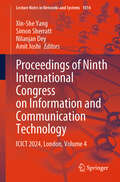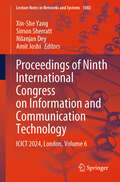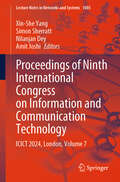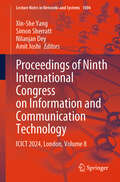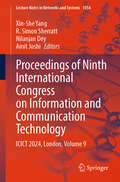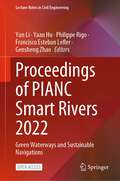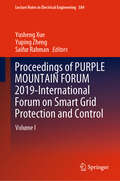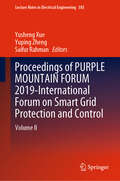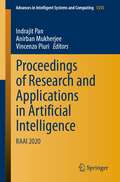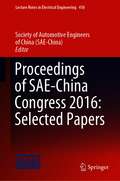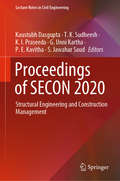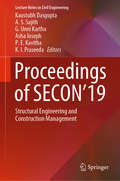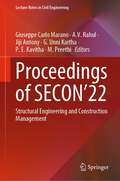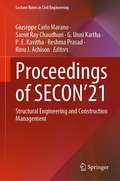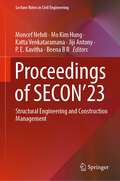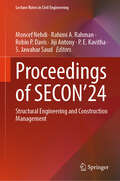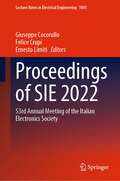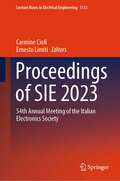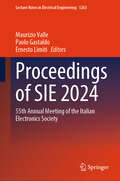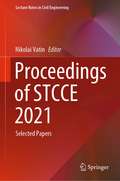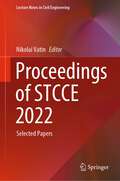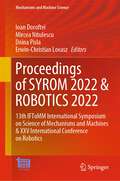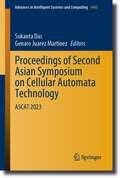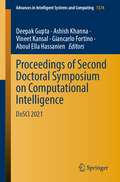- Table View
- List View
Proceedings of Ninth International Congress on Information and Communication Technology: ICICT 2024, London, Volume 4 (Lecture Notes in Networks and Systems #1014)
by Xin-She Yang Nilanjan Dey Amit Joshi Simon SherrattThis book gathers selected high-quality research papers presented at the Ninth International Congress on Information and Communication Technology, held at Brunel University, London, on February 19–22, 2024. It discusses emerging topics pertaining to information and communication technology (ICT) for managerial applications, e-governance, e-agriculture, e-education and computing technologies, the Internet of Things (IoT), and e-mining. Written by respected experts and researchers working on ICT, the book offers an asset for young researchers involved in advanced studies. The work is presented in ten volumes.
Proceedings of Ninth International Congress on Information and Communication Technology: ICICT 2024, London, Volume 5 (Lecture Notes in Networks and Systems #1000)
by Xin-She Yang Nilanjan Dey Amit Joshi Simon SherrattThis book gathers selected high-quality research papers presented at the Ninth International Congress on Information and Communication Technology, held at Brunel University, London, on 19–22 February 2024. It discusses emerging topics pertaining to information and communication technology (ICT) for managerial applications, e-governance, e-agriculture, e-education and computing technologies, the Internet of Things (IoT), and e-mining. Written by respected experts and researchers working on ICT, the book offers an asset for young researchers involved in advanced studies. The book is presented in 10 volumes.
Proceedings of Ninth International Congress on Information and Communication Technology: ICICT 2024, London, Volume 6 (Lecture Notes in Networks and Systems #1002)
by Xin-She Yang Nilanjan Dey Amit Joshi Simon SherrattThis book gathers selected high-quality research papers presented at the Ninth International Congress on Information and Communication Technology, held at Brunel University, London, on 19–22 February 2024. It discusses emerging topics pertaining to information and communication technology (ICT) for managerial applications, e-governance, e-agriculture, e-education and computing technologies, the Internet of Things (IoT), and e-mining. Written by respected experts and researchers working on ICT, the book offers an asset for young researchers involved in advanced studies. The book is presented in 10 volumes.
Proceedings of Ninth International Congress on Information and Communication Technology: ICICT 2024, London, Volume 7 (Lecture Notes in Networks and Systems #1003)
by Xin-She Yang Nilanjan Dey Amit Joshi Simon SherrattThis book gathers selected high-quality research papers presented at the Ninth International Congress on Information and Communication Technology, held at Brunel University, London, on 19–22 February 2024. It discusses emerging topics pertaining to information and communication technology (ICT) for managerial applications, e-governance, e-agriculture, e-education and computing technologies, the Internet of Things (IoT), and e-mining. Written by respected experts and researchers working on ICT, the book offers an asset for young researchers involved in advanced studies. The book is presented in 10 volumes.
Proceedings of Ninth International Congress on Information and Communication Technology: ICICT 2024, London, Volume 8 (Lecture Notes in Networks and Systems #1004)
by Xin-She Yang Nilanjan Dey Amit Joshi Simon SherrattThis book gathers selected high-quality research papers presented at the Ninth International Congress on Information and Communication Technology, held at Brunel University, London, on 19–22 February 2024. It discusses emerging topics pertaining to information and communication technology (ICT) for managerial applications, e-governance, e-agriculture, e-education and computing technologies, the Internet of Things (IoT), and e-mining. Written by respected experts and researchers working on ICT, the book offers an asset for young researchers involved in advanced studies. The book is presented in 10 volumes.
Proceedings of Ninth International Congress on Information and Communication Technology: ICICT 2024, London, Volume 9 (Lecture Notes in Networks and Systems #1054)
by Xin-She Yang Nilanjan Dey Amit Joshi R. Simon SherrattThis book gathers selected high-quality research papers presented at the Ninth International Congress on Information and Communication Technology, held at Brunel University, London, on February 19–22, 2024. It discusses emerging topics pertaining to information and communication technology (ICT) for managerial applications, e-governance, e-agriculture, e-education and computing technologies, the Internet of Things (IoT) and e-mining. Written by respected experts and researchers working on ICT, the book offers an asset for young researchers involved in advanced studies. The work is presented in ten volumes.
Proceedings of PIANC Smart Rivers 2022: Green Waterways and Sustainable Navigations (Lecture Notes in Civil Engineering #264)
by Yun Li Yaan Hu Philippe Rigo Francisco Esteban Lefler Gensheng ZhaoThis book is a compilation of selected papers from the 10th PIANC Smart Rivers Conference (Smart Rivers 2022). The work focuses on novel techniques for inland waterways and navigation structures. The contents make valuable contributions to academic researchers, engineers in the industry, and regulators of aviation authorities. As well, readers will encounter new ideas for realizing Green Waterways and Sustainable Navigations. This is an open access book.
Proceedings of PURPLE MOUNTAIN FORUM 2019-International Forum on Smart Grid Protection and Control: Volume I (Lecture Notes in Electrical Engineering #584)
by Yusheng Xue Saifur Rahman Yuping ZhengThis book presents original, peer-reviewed research papers from the 4th Purple Mountain Forum –International Forum on Smart Grid Protection and Control (PMF2019-SGPC), held in Nanjing, China on August 17–18, 2019. Addressing the latest research hotspots in the power industry, such as renewable energy integration, flexible interconnection of large scale power grids, integrated energy system, and cyber physical power systems, the papers share the latest research findings and practical application examples of the new theories, methodologies and algorithms in these areas. As such book a valuable reference for researchers, engineers, and university students.
Proceedings of PURPLE MOUNTAIN FORUM 2019-International Forum on Smart Grid Protection and Control: Volume II (Lecture Notes in Electrical Engineering #585)
by Yusheng Xue Saifur Rahman Yuping ZhengThis book presents original, peer-reviewed research papers from the 4th Purple Mountain Forum –International Forum on Smart Grid Protection and Control (PMF2019-SGPC), held in Nanjing, China on August 17–18, 2019. Addressing the latest research hotspots in the power industry, such as renewable energy integration, flexible interconnection of large scale power grids, integrated energy system, and cyber physical power systems, the papers share the latest research findings and practical application examples of the new theories, methodologies and algorithms in these areas. As such book a valuable reference for researchers, engineers, and university students.
Proceedings of Research and Applications in Artificial Intelligence: RAAI 2020 (Advances in Intelligent Systems and Computing #1355)
by Vincenzo Piuri Anirban Mukherjee Indrajit PanThis book discusses the recent research trends and upcoming applications based on artificial intelligence. It includes best selected research papers presented at the International Conference on Research and Applications in Artificial Intelligence (RAAI 2020), organized by Department of Information Technology, RCC Institute of Information technology, Kolkata, West Bengal, India during 19 – 20, December, 2020. Many versatile fields of artificial intelligence are categorically addressed through different chapters of this book. The book is a valuable resource and reference for researchers, instructors, students, scientists, engineers, managers and industry practitioners in these important areas.
Proceedings of SAE-China Congress 2016: Selected Papers (Lecture Notes in Electrical Engineering #418)
by China Society of Automotive EngineersThis proceedings volume gathers outstanding papers submitted to the 2016 SAE-China Congress, the majority of which are from China, the biggest car maker as well as most dynamic car market in the world. The book includes insights into the current challenges that the whole industry is currently facing, and it offers possible solutions to problems such as emission controls, environmental pollution, the energy shortage, traffic congestion and sustainable development. It also presents the latest technical achievements in the automotive industry. Many of the approaches it presents can help technicians to solve the practical problems that most affect their daily work.
Proceedings of SECON 2020: Structural Engineering and Construction Management (Lecture Notes in Civil Engineering #97)
by Kaustubh Dasgupta G. Unni Kartha P. E. Kavitha K. I. Praseeda T. K. Sudheesh S. Jawahar SaudThis book gathers peer-reviewed contributions presented at the 1st International Conference on Structural Engineering and Construction Management (SECON’20), held in Angamaly, Kerala, India, on 14-15 May 2020. The meeting served as a fertile platform for discussion, sharing sound knowledge and introducing novel ideas on issues related to sustainable construction and design for the future. The respective contributions address various aspects of numerical modeling and simulation in structural engineering, structural dynamics and earthquake engineering, advanced analysis and design of foundations, BIM, building energy management, and technical project management. Accordingly, the book offers a valuable, up-to-date tool and essential overview of the subject for scientists and practitioners alike, and will inspire further investigations and research.
Proceedings of SECON'19: Structural Engineering and Construction Management (Lecture Notes in Civil Engineering #46)
by Kaustubh Dasgupta A. S. Sajith G. Unni Kartha Asha Joseph P. E. Kavitha K. I. PraseedaThis book gathers peer-reviewed contributions presented at the 3rd National Conference on Structural Engineering and Construction Management (SECON’19), held in Angamaly, Kerala, India, on 15-16 May 2019. The meeting served as a fertile platform for discussion, sharing sound knowledge and introducing novel ideas on issues related to sustainable construction and design for the future. The respective contributions address various aspects of numerical modeling and simulation in structural engineering, structural dynamics and earthquake engineering, advanced analysis and design of foundations, BIM, building energy management, and technical project management. Accordingly, the book offers a valuable, up-to-date tool and essential overview of the subject for scientists and practitioners alike, and will inspire further investigations and research.
Proceedings of SECON'22: Structural Engineering and Construction Management (Lecture Notes in Civil Engineering #284)
by G. Unni Kartha P. E. Kavitha Giuseppe Carlo Marano A. V. Rahul Jiji Antony M. PreethiThis book gathers peer-reviewed contributions presented at the 3rd International Conference on Structural Engineering and Construction Management (SECON’22), held in Angamaly, Kerala, India, on 1-3 June 2022. The meeting served as a fertile platform for discussion, sharing sound knowledge and introducing novel ideas on issues related to sustainable construction and design for the future. The respective contributions address various aspects of numerical modeling and simulation in structural engineering, structural dynamics and earthquake engineering, advanced analysis and design of foundations, BIM, building energy management, and technical project management. Accordingly, the book offers a valuable, up-to-date tool and essential overview of the subject for scientists and practitioners alike, and will inspire further investigations and research.
Proceedings of SECON’21: Structural Engineering and Construction Management (Lecture Notes in Civil Engineering #171)
by G. Unni Kartha P. E. Kavitha Giuseppe Carlo Marano Samit Ray Chaudhuri Reshma Prasad Rinu J. AchisonThis book gathers peer-reviewed contributions presented at the International Conference on Structural Engineering and Construction Management (SECON’21), held on 12-15 May 2021. The meeting served as a fertile platform for discussion, sharing sound knowledge and introducing novel ideas on issues related to sustainable construction and design for the future. The respective contributions address various aspects of numerical modeling and simulation in structural engineering, structural dynamics and earthquake engineering, advanced analysis and design of foundations, BIM, building energy management, and technical project management. Accordingly, the book offers a valuable, up-to-date tool and essential overview of the subject for scientists and practitioners alike, and will inspire further investigations and research.
Proceedings of SECON’23: Structural Engineering and Construction Management (Lecture Notes in Civil Engineering #381)
by P. E. Kavitha Jiji Antony Moncef Nehdi Mo Kim Hung Katta Venkataramana Beena B RThis book gathers peer-reviewed contributions presented at the 4th International Conference on Structural Engineering and Construction Management (SECON’23), held in Angamaly, Kerala, India, on 7-9 June 2023. The meeting served as a fertile platform for discussion, sharing sound knowledge and introducing novel ideas on issues related to sustainable construction and design for the future. The respective contributions address various aspects of numerical modeling and simulation in structural engineering, structural dynamics and earthquake engineering, advanced analysis and design of foundations, BIM, building energy management, and technical project management. Accordingly, the book offers a valuable, up-to-date tool and essential overview of the subject for scientists and practitioners alike, and will inspire further investigations and research.
Proceedings of SECON’24: Structural Engineering and Construction Management (Lecture Notes in Civil Engineering #607)
by P. E. Kavitha S. Jawahar Saud Jiji Antony Moncef Nehdi Rahimi A. Rahman Robin P. DavisThis book gathers peer-reviewed contributions presented at the 5th International Conference on Structural Engineering and Construction Management (SECON’24), held in Angamaly, Kerala, India, on 5–7 June 2024. The meeting served as a fertile platform for discussion, sharing sound knowledge and introducing novel ideas on issues related to sustainable construction and design for the future. The respective contributions address various aspects of numerical modeling and simulation in structural engineering, structural dynamics and earthquake engineering, advanced analysis and design of foundations, BIM, building energy management, and technical project management. Accordingly, the book offers a valuable, up-to-date tool and essential overview of the subject for scientists and practitioners alike, and will inspire further investigations and research.
Proceedings of SIE 2022: 53rd Annual Meeting of the Italian Electronics Society (Lecture Notes in Electrical Engineering #1005)
by Ernesto Limiti Giuseppe Cocorullo Felice CrupiThis book showcases the state of the art in the field of electronics, as presented by researchers and engineers at the 53rd Annual Meeting of the Italian Electronics Society (SIE), held in Rende (CS), Italy, on September 5-7, 2022. It covers a broad range of aspects, including: integrated circuits and systems, micro- and nano-electronic devices, microwave electronics, sensors and microsystems, optoelectronics and photonics, power electronics, electronic systems and applications.
Proceedings of SIE 2023: 54th Annual Meeting of the Italian Electronics Society (Lecture Notes in Electrical Engineering #1113)
by Ernesto Limiti Carmine CiofiThis book showcases the state of the art in the field of electronics, as presented by researchers and engineers at the 54th Annual Meeting of the Italian Electronics Society (SIE), held in Noto (SR), Italy, on September 6–8, 2023. It covers a broad range of aspects, including: integrated circuits and systems, micro- and nano-electronic devices, microwave electronics, sensors and microsystems, optoelectronics and photonics, power electronics, electronic systems and applications.
Proceedings of SIE 2024: 55th Annual Meeting of the Italian Electronics Society (Lecture Notes in Electrical Engineering #1263)
by Maurizio Valle Ernesto Limiti Paolo GastaldoThis book showcases the state of the art in the field of electronics, as presented by researchers and engineers at the 55th Annual Meeting of the Italian Electronics Society (SIE), held in Genoa, Italy, on June 26–28, 2024. It covers a broad range of aspects, including: integrated circuits and systems, micro- and nano-electronic devices, microwave electronics, sensors and microsystems, optoelectronics and photonics, power electronics, electronic systems and applications.
Proceedings of STCCE 2021: Selected Papers (Lecture Notes in Civil Engineering #169)
by Nikolai VatinThis book gathers selected contributions in the field of civil and construction engineering, as presented by international researchers and engineers at the 2nd International Scientific Conference on Socio-Technical Construction and Civil Engineering (STCCE), held in Kazan, Russia on April 21-28 2021. The book covers a wide range of topics including building constructions and structures, bridges, roads and tunnels, building materials and products, construction management, energy efficiency and thermal protection of buildings, ventilation, air conditioning, gas supply and lighting in buildings, innovative and smart technologies in construction, sustainable development, transport system development. The contributions, which were selected by means of a rigorous international peer-review process, highlight numerous exciting ideas that will spur novel research directions and foster multidisciplinary collaborations.
Proceedings of STCCE 2022: Selected Papers (Lecture Notes in Civil Engineering #291)
by Nikolai VatinThis book gathers selected contributions in the field of civil and construction engineering, as presented by international researchers and engineers at the 3rd International Scientific Conference on Socio-Technical Construction and Civil Engineering (STCCE), held in Kazan, Russia on April 21-29 2022. The book covers a wide range of topics including building constructions and structures, bridges, roads and tunnels, building materials and products, energy efficiency and thermal protection of buildings, ventilation, air conditioning, gas supply and lighting in buildings, innovative and smart technologies in construction, transport system development. The contributions, which were selected by means of a rigorous international peer-review process, highlight numerous exciting ideas that will spur novel research directions and foster multidisciplinary collaborations.
Proceedings of SYROM 2022 & ROBOTICS 2022: 13th IFToMM International Symposium on Science of Mechanisms and Machines & XXV International Conference on Robotics (Mechanisms and Machine Science #127)
by Erwin-Christian Lovasz Doina Pisla Ioan Doroftei Mircea NitulescuThis volume presents the proceedings of the Joint International Conference of the 13th IFToMM International Symposium on Science of Mechanisms and Machines (SYROM) & the XXV International Conference on Robotics (ROBOTICS), held in Iasi, Romania, on November 17–18, 2022. It brought together researchers, scientists and industry experts involved in the area of mechanisms, mechanical transmissions, robotics and mechatronics, to disseminate their latest research results and exchange views on the future research directions of these fields. The book presents original high-quality contributions on topics such as theoretical and computational kinematics, mechanism design, experimental mechanics, dynamics of machinery and multi-body systems, mechanisms for biomechanics, mechanical transmissions, linkages and mechanical controls, micromechanisms, serial and parallel robots, mobile and collaborative robots, micro and nano robots, sensors and actuators, medical robots, haptics, and virtual reality.
Proceedings of Second Asian Symposium on Cellular Automata Technology: ASCAT 2023 (Advances in Intelligent Systems and Computing #1443)
by Sukanta Das Genaro Juarez MartinezThis book gathers selected research papers presented at the Second Asian Symposium on Cellular Automata Technology (ASCAT 2023), organized by academicians from Kolkata at Indian Institute of Engineering Science and Technology, Shibpur, West Bengal, India, and by researchers of Cellular Automata India, a research group which was created during the pandemic, during March 2–4, 2023. The book presents one of the most emergent areas in natural computing, cellular automaton (CA). CA is a paradigm of uniform fine-grained parallel computation which has been explored to understand complex systems by developing its model at the microscopic level. The book discusses many real-life problems in the domain of pattern recognition and classification, clustering, electronic circuit design, bioinformatics, material and mining engineering, modelling of physical and social systems, etc., by using CA.
Proceedings of Second Doctoral Symposium on Computational Intelligence: DoSCI 2021 (Advances in Intelligent Systems and Computing #1374)
by Giancarlo Fortino Aboul Ella Hassanien Deepak Gupta Ashish Khanna Vineet KansalThis book features high-quality research papers presented at Second Doctoral Symposium on Computational Intelligence (DoSCI-2021), organized by Institute of Engineering and Technology (IET), AKTU, Lucknow, India, on 6 March 2021. This book discusses the topics such as computational intelligence, artificial intelligence, deep learning, evolutionary algorithms, swarm intelligence, fuzzy sets and vague sets, rough set theoretic approaches, quantum-inspired computational intelligence, hybrid computational intelligence, machine learning, computer vision, soft computing, distributed computing, parallel and grid computing, cloud computing, high-performance computing, biomedical computing, decision support and decision making.
